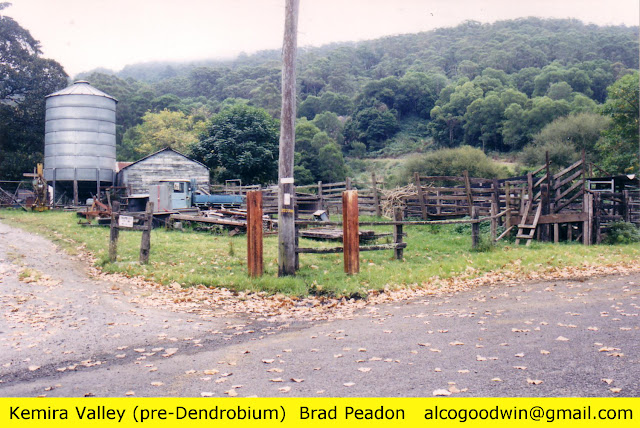G'day again, I returneth with another dreary post for the world too scoff at and make snide remarks about.
We return to the Illawarra region of New South Wales, this time little north of the Elouera (Wongawilli) railway that I recently covered.
Unlike the Wonga line, this one is still in operation, and still feeds coal to the Bluescope Steelworks at Port Kembla. The coverage is mostly all prior to the Dendrobium project which truly violated the look and feel of the valley the coal loader was situated in.
Kemira Coal Loader

The following shots were taken for a proposed modelling project. Both the Kemira yard, and Central Kembla loop, were considered for an exhibition layout over the years.
Alas, to date, neither have been done.
But the idea still occasionally raises its head.
Oh, and before the usual boring expressions of panic come forth from the self-appointed railfan police.
Yes, we were there with an employee and not just trespassing willy-nilly.
Yes, we were there with an employee and not just trespassing willy-nilly.
So please go share your misery elsewhere.
D40 (left) and D47 loading their respective trains under the Kemira bins. D40 is the sole survivor of her type in 2021, while D47 was later sold and has since been scrapped.
Looking towards the end of the line from under the bins.
Interesting signalling setup at the entrance to the yards.
I am none to qualified to explain it, but think the road type lights permitted entry to the yard/bins.
While the red/green light indicated to the train driver when to push the train back for further loading of each hopper.
While the red/green light indicated to the train driver when to push the train back for further loading of each hopper.
I stand to be corrected on both counts.
D34 was BHP's big power, well of those locos purchased new for the steelworks.
This beast originally mostly saw use on the Elouera/Wongawilli line, but the arrival of the K class would of greatly freed her up from that duty.
D36 shunting Kemira late one night.
This locomotive has since been scrapped.
D34 is loading, while ALCo 103 arrives with another rake of emptied.
Interestingly, both these locomotives are now preserved. D34 at at State Mine in Lithgow, while 103 at Tailem Bend in South Australia.
Interestingly, both these locomotives are now preserved. D34 at at State Mine in Lithgow, while 103 at Tailem Bend in South Australia.
Preserved steam locomotive 5910 makes a rare appearance in the valley.
5910 was built by 'Baldwin Lima Hamilton' in 1952 and is preserved at Thirlmere.
Two trains being loaded . Taken from the west end of the yard.
While not immensely common, the two Austrac Jumbos did make visits to the valley. The two Silverton ones, as seen in the earlier Wongawilli article, are not believed to have done same.
Now scrapped D43, one of the last two steelworks locomotives in the red livery, is seen at Kemira after having arrived on a tour.
Before we move on, here are a couple of photos showing the early stages of the Dendrobium development. I have photos taken of the official opening, and subsequent operations, that I shall include here once they be located and scanned.
Located just east of the Kemira Valley yard.
This section of track along Cordeaux Road was always popular for photos. Unfortunately, today a tall fence and overgrowth have ruined the spot.
The line diverges away from the roadside, and crosses American Creek, as it approaches the location of the former Central Kembla crossing loop.
For many years this white cross existed between the Cordeaux Road bridge and loop points.
This marked the location of a tragic, and fatal, head on collision between trains lead by D35 and D37.

This marked the location of a tragic, and fatal, head on collision between trains lead by D35 and D37.

8117 hauling empties up to the mine. Only a few of this locomotive class actually carried the National Rail livery, so I was glad to capture this one.
Preserved BRONZEWING in the same spot, back in the days when the steelworks cared about their history.
BRONZEWING has since returned to the railway museum at Thirlmere, the carriages are at the museum in Oberon, while the tanker is way up north at Tenterfield station.
The advent of Dendrobium saw the arrival of the 82 class on the line. In 2021, this class still carries out all haulage to Kemira.

West end entrance to the Central Kembla loop.
This gate, at the east end of the Central Kembla loop, retained the 'Australian Iron and Steel' initials long after the steelworks had become BHP owned.
Today the gate has been removed, but it is hoped it has been retained by someone.
Today the gate has been removed, but it is hoped it has been retained by someone.
East end of the Central Kembla loop and Central Road level crossing which appears to just fall inside the suburb of Figtree according to Google Maps.
Now scrapped D36 with a loaded Kemira coal train is seen about to pass over the Central Road crossing.
After continuing downgrade behind housing, the line crosses over the Princes Highway, and main Illawarra Railway, as it enters Unanderra.
8206 leads a rake of empty coal hoppers under the Princess Motorway, and across a private crossing, at Unanderra.
To finish up, we have a brief look at the old Nebo formation before it was turned into a parkland and footpath/bike track.
As can be seen in the maps above, the Kemira loader was once accessed via this section of the Nebo line. It was later diverted via a new, and direct, track that still is used today.




















































































